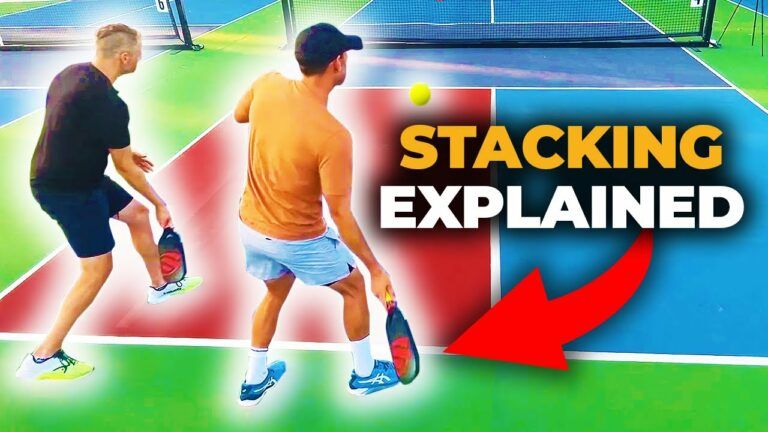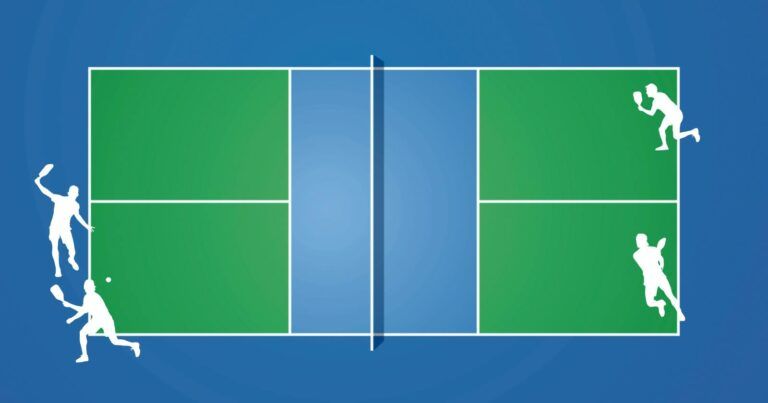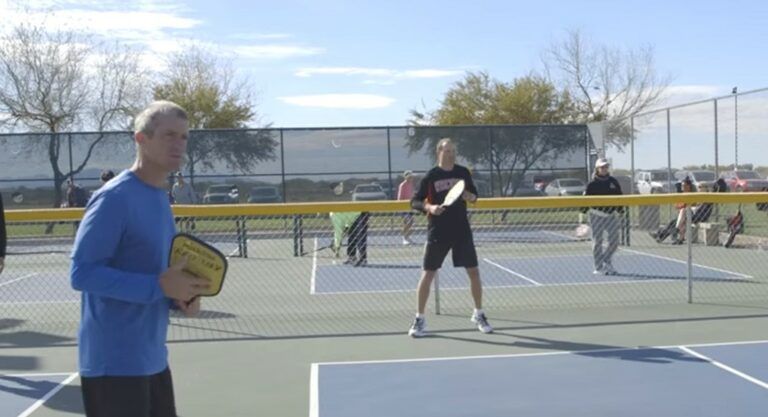What is stacking in pickleball?
At its core, stacking is a strategic formation primarily utilized in doubles play. By aligning on the same side of the court, partners can maintain preferred positioning and effectively utilize their strengths throughout the game a deviation from the traditional side-by-side positioning of doubles play. Picture this: while one player might be exceptionally strong on their forehand, the other might struggle with their backhand. By stacking, the strong player takes charge of the center, maximizing potent shots while the other navigates their weaknesses.

To illustrate the difference clearly, envision the traditional doubles setup where partners situate themselves on opposite sides. Each player has to alternate between covering their strong and weak sides. In contrast, the stacked formation allows players to focus on their strengths and cover the mid-court area more efficiently.
This adaptation is especially advantageous when teams consist of a left-handed and a right-handed player, providing unique coverage of the court's central area. Players can iterate and adjust these positions, generating a potent synergy that traditional formations often lack.
Why stack in pickleball?
Utilizing the stacking approach introduces multiple benefits, offering profound advantages, especially for beginners. One of the key perks is the ability to improve positioning by ensuring players remain on their stronger side, thereby maximizing their performance. This simplified strategy allows players to manage the dynamics of the game while reducing confusion, making it an essential tool for success in double

Benefits for beginners
- Improved Positioning: Staying on a player’s preferred side like avoiding a backhand shot can significantly enhance their accuracy and power. This approach simplifies court positioning and minimizes potential confusion during fast-paced plays.
- Play to Strengths: Stacking allows players to consistently engage in shots they excel at. For instance, a player with a dominant forehand can anchor the middle and dictate the pace of the game.
- Minimize Confusion: By staying on the same side, players avoid the disorientation that often comes with switching sides, allowing smoother transitions, especially in tense match situations.
Through leveraging these advantages, beginners can cultivate a winning mentality on the court while gaining confidence in their ability to cooperate with a partner.
Common stacking scenarios
When it comes to stacking, various scenarios showcase its potential effectiveness. For instance, teams containing a left-handed player often find themselves stacking to have both of their powerful forehands in the middle, capitalizing on angles that are difficult for opponents to counter. Furthermore, stacking can effectively hide a weaker backhand, permitting the stronger player to assert their dominance over the middle ground and capitalize on opportunities.
In these scenarios, visualization and practice can help players harness the stacking strategy effectively. Being adaptable and observant about both the opposing team's weaknesses and personal strengths will enable players to execute stacking successfully, thus enhancing their overall gameplay.
How to stack in pickleball
Whether serving or receiving, understanding the mechanics of stacking is essential for success in this strategic formation. The techniques surrounding stacking can be broken down into specific approaches, each designed to optimize court coverage and positioning.
Stacking on the serve
When players stack while serving, they initiate their positions on the same side of the court. Here’s a step-by-step guide that elucidates this process:

- Starting Point: Both partners prepare on the same side, with one serving from the correct service box.
- Serve Execution: The player serves the ball while their partner stands adjacent and ready for the next move.
- Post-Service Transition: After the serve, as the rally unfolds, one player transitions to the opposite side of the court while the other remains in position, allowing flexibility to return to preferred spots efficiently.
By strategically shifting after a point is scored, players create advantageous angles and maintain a cohesive formation, maximizing their effectiveness during play.
Stacking on the return
There are different approaches to stacking when it comes to returning serves, namely the traditional stack and the switch stack.

- Traditional Stack:
- Players maintain the stacked formation while receiving serves.
- As the serve is made, both players remain close together, setting up their strong shots as they anticipate the ball.
- Switch Stack: - Players adjust positions after the serve.
- This allows one player to stay on their strong side while the other plays a more adaptive role, ensuring coverage of both court sides.
Mechanics and Strategies
Considerations must be taken when employing each approach:
- With the traditional stack, both players can exert control over the center, allowing for more synchronized movements.
- The switch stack offers strategic flexibility, adapting to the dynamics of play as needed.
This versatility heightens a team’s performance, allowing them to exploit opponents' weaknesses while maintaining a cohesive structure.
Communicating while stacking
Effective communication stands as the crux of successful stacking in pickleball. Without clear cues and signals, even the most well-positioned teams can falter, leading to confusion and missed opportunities. Coordinating movements with non-verbal signals is a key component that ensures smooth transitions during gameplay.
Why communication matters
Endeavors in stacking require a solid framework of communication. Miscommunication can lead to faults players inadvertently stepping into each other's space or failing to cover necessary areas of the court. Thus, clear communication helps avoid errors while enhancing the overall effectiveness of the stacking formation.
Common pickleball stacking signals
Implementing standard hand signals can facilitate seamless coordination between partners. Here are some fundamental cues:
- Switch Signal: Often represented by an open hand, indicating players should switch positions.
- Stay Signal: A closed fist indicates players should maintain their current positions.
Employing these signals helps partners keep track of movements and ensures cohesive action during critical gameplay moments. Training with a partner to reinforce the significance of using signaling effectively enhances court awareness and improves movement coordination, resulting in an overall more cohesive teamwork experience.
Common stacking mistakes to avoid
While stacking can greatly enhance performance, players can easily fall into pitfalls that compromise court dynamics. Recognizing these potential mistakes and adjusting strategies accordingly can ensure smooth stacking implementation.
Losing track of position
One frequent error when stacking is losing track of the designated serving and receiving order. This often arises from the chaotic nature of gameplay or forgetting basic position rules. To counteract this, players can utilize visual reminders and establish clear communication. For instance, before each point, partners can reinforce which positions they are assigned to maintain clarity in their movements.
Rushing the transition
Another common mistake occurs when players rush transitions, especially during the return phase. For instance, following a strong serve, a player may overshoot rather than ensuring their position is secure. This often leads to gaps in court coverage, making the team susceptible to opponents' attacks. Emphasizing the importance of meticulous positioning can mitigate these lapses in effective stacking.
Variations on stacking
Stacking can be customized to fit player needs and team dynamics, resulting in several variations. Each style has its pros and cons, providing flexibility in how teams approach the game.
Half stacking
This approach involves teams choosing to stack only during serves, reverting to traditional positioning during returns. This strategy can help those who may have one player with limited mobility, allowing flexibility on the court while optimizing their strengths during serves.
Three-quarters stacking
Three-quarters stacking sees teams implementing stacking for all serves and half of the returns. This setup maintains the advantage of powerful forehands in the mid-court area, accommodating less agile players on the team while ensuring that they still capitalize on their strengths effectively.
Countering opponents who stack
Recognizing that opponents may employ stacking techniques themselves, players need strategic countermeasures to exploit any potential weaknesses. Being observant during matches can reveal opponents' patterns, which can uncover opportunities for advancing gameplay.
Identifying opponent weaknesses
By observing how opponents stack, players can determine their vulnerabilities. Noting weaknesses like slower footwork or a weaker backhand allows teams to target those areas effectively. For example, if a stacked formation reveals a player frequently forced to cover the breadth of the court, exploiting this gap can apply pressure and create winning chances.
Attacking the transition
An effective tactic is to focus on the player transitioning during a stack. Forcing shots at the transitioning player can put them in uncomfortable positions, disrupting their rhythm and providing opportunities to capitalize on their mistakes. Crafting shots that exploit gaps in coverage during the transition phase can turn the tide in favor of the attacking team.
Practicing stacking
To incorporate stacking effectively into gameplay, dedicated practice is essential. Best practices involve implementing drills that enhance both teamwork and individual understanding of the strategy.
Drills for stacking mechanics
Engaging in movement and communication drills with a partner can significantly hone stacking skills. These practice sessions can focus on timing, transitioning, and other lateral movements, reducing confusion during actual matches.
Simulating game situations
It’s equally critical to simulate game-like situations in practice, centering efforts on quick decision-making under pressure. Practice matches that incorporate stacking can build comfort and coordination as players work through realistic scenarios, reinforcing their strategies and understanding during high-stakes moments.
When not to stack in pickleball
While stacking has its advantages, there are certain situations where this technique may not be suitable. Understanding your limitations and those of your partner is crucial in deciding whether stacking is the right choice in a match.
Player limitations
In cases where players have limited mobility or a significant weakness such as an ineffective backhand the stacking strategy may not be favorable. Teams should assess their strengths and weaknesses honestly before committing to a stacking approach, to avoid potential pitfalls.
Focus on fundamentals
Beginner players, especially, should prioritize mastering fundamental skills before diving into complex strategies like stacking. A solid foundation in these basic skills simplifies gameplay and ensures players can maximize the benefits of stacking later on.
Conclusion
In summarizing the intricate tapestry of stacking in pickleball, it’s clear that this technique provides teams with a strategic advantage that elevates gameplay. From maximizing individual strengths to enhancing communication and teamwork, stacking is indeed a valuable tool for players aiming to increase their proficiency on the court. As you practice stacking with your partner, experiment with different approaches and observations during matches. Overall, this strategic and cooperative strategy invites players to immerse themselves in the joy and excitement of pickleball, ultimately improving their gameplay experience and enhancing their overall enjoyment of the game.










